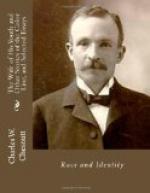According to all his preconceived notions, this marriage ought to have been the acme of uncle Wellington’s felicity. But he soon found that it was not without its drawbacks. On the following morning Mr. Todd was informed of the marriage. He had no special objection to it, or interest in it, except that he was opposed on principle to having husband and wife in his employment at the same time. As a consequence, Mrs. Braboy, whose place could be more easily filled than that of her husband, received notice that her services would not be required after the end of the month. Her husband was retained in his place as coachman.
Upon the loss of her situation Mrs. Braboy decided to exercise the married woman’s prerogative of letting her husband support her. She rented the upper floor of a small house in an Irish neighborhood. The newly wedded pair furnished their rooms on the installment plan and began housekeeping.
There was one little circumstance, however, that interfered slightly with their enjoyment of that perfect freedom from care which ought to characterize a honeymoon. The people who owned the house and occupied the lower floor had rented the upper part to Mrs. Braboy in person, it never occurring to them that her husband could be other than a white man. When it became known that he was colored, the landlord, Mr. Dennis O’Flaherty, felt that he had been imposed upon, and, at the end of the first month, served notice upon his tenants to leave the premises. When Mrs. Braboy, with characteristic impetuosity, inquired the meaning of this proceeding, she was informed by Mr. O’Flaherty that he did not care to live in the same house “wid naygurs.” Mrs. Braboy resented the epithet with more warmth than dignity, and for a brief space of time the air was green with choice specimens of brogue, the altercation barely ceasing before it had reached the point of blows.
It was quite clear that the Braboys could not longer live comfortably in Mr. O’Flaherty’s house, and they soon vacated the premises, first letting the rent get a couple of weeks in arrears as a punishment to the too fastidious landlord. They moved to a small house on Hackman Street, a favorite locality with colored people.
For a while, affairs ran smoothly in the new home. The colored people seemed, at first, well enough disposed toward Mrs. Braboy, and she made quite a large acquaintance among them. It was difficult, however, for Mrs. Braboy to divest herself of the consciousness that she was white, and therefore superior to her neighbors. Occasional words and acts by which she manifested this feeling were noticed and resented by her keen-eyed and sensitive colored neighbors. The result was a slight coolness between them. That her few white neighbors did not visit her, she naturally and no doubt correctly imputed to disapproval of her matrimonial relations.




